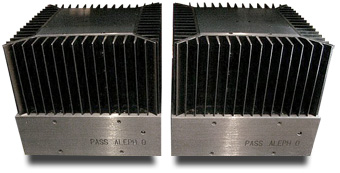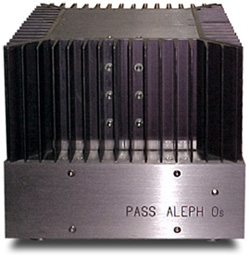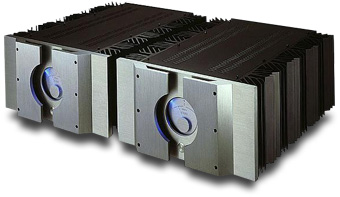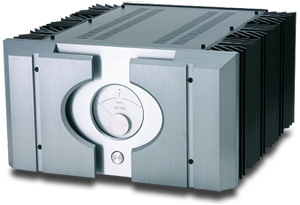 |
| March 1, 2008 Searching for the Extreme: Nelson Pass of Pass LabsIf you’ve ever attended an audio event such as the Consumer Electronics Show or Munich’s High End, or if you’ve read about them in the press, you’ve likely spotted a white-haired fellow in suit and sneakers talking about electronics design. That would be Nelson Pass. And if you’re an audiophile, you’ve probably heard one of his designs or, if you’re lucky, owned one yourself. Background Nelson Pass grew up in northern California, where he attended UC Davis and earned a degree in physics. Most audiophiles came to know Pass through his work at the Threshold Corporation, where he resided from 1975 until 1991, when he founded Pass Laboratories. Pass’s career in the audio business is legendary. He holds seven audio patents, six of them for amplifier circuits. Among his early accomplishments were the "first dynamically biased class-A circuit" (1974), "a fully cascode audio power amplifier" (1976), and the famous "Stasis" amplifiers (1977) -- models that are still highly sought on the used market. Pass’s work at Pass Labs has been perhaps his most fruitful. The popular Aleph series of amplifiers used single-ended, class-A circuits. Later was Pass’s Super-Symmetric circuit, "which exploits the properties of symmetric balanced circuits and symmetric feedback to obtain low distortion and noise from very simple circuits." The first Pass amplifier based on a Super-Symmetric circuit was the massive X1000, which delivered 1000W from only two gain stages: "a differential input pair of transistors and a large bank of output followers." At www.diyaudio.org you’ll find a forum dedicated solely to Pass Labs. There’s some talk of his commercial products, but most of what you’ll find are discussions of do-it-yourself audio gear to which Nelson Pass contributes designs, advice to hobbyists, and general support for all manner of audio questions. In fact, such has been his support of the build-it-yourself hobbyist that his pet name among that DIY community is "Papa." According to Papa Pass, to date there have been over 30 Nelson Pass audio designs published for use by hobbyists -- of note is the popular single-stage Zen series. I’m sometimes asked what I would buy if were looking for a classic audio product. I rarely recommend a specific model -- much of the older stuff will be in need of service, and won’t hold up to today’s designs. There are a few exceptions, however, and the early work of Nelson Pass is at the top of that list. Below is a catalog of some of his more famous designs, and what was technically special about them. Although all of these models have been discontinued, new Pass Labs products are available from a worldwide network of dealers. The following information was provided by Nelson Pass. Threshold 800A power amplifier "In 1975, the 800A was the first amplifier to actively adjust the bias of the output stage so as to maintain class-A forward bias over the whole operating cycle of the output. In doing so, it dramatically reduced the amount of idling power required to run the amplifier and allowed much higher output power than previously. Previous class-A designs dissipated at least twice the rated power all the time, but the 800A idled at its rated power of 200Wpc. "The 800A had a number of other innovations for its time. The output stage was the first example of a triple-series, triple-parallel, triple-Darlington topology. It was one of the first amplifiers offering a high slew rate and low TIM distortion, and featured 0.01% IM distortion in a test using audio test frequencies mixed with 80kHz. "The 800A was also one of the first amplifiers to have a straight-through output connection without a coil for stability, and yet it earned its reputation driving difficult electrostatic loudspeakers such as the Dayton-Wrights. It featured input/output comparison circuitry which warned of distorted output, and also protected the amplifier and speaker from faults. It had a user-controlled soft-clip circuit which kept the amplifier out of hard clipping and protected sensitive loudspeakers from damage. There were about 150 units of this amplifier made." Threshold Stasis 1 power amplifier "The Stasis 1 was the statement product for what became the popular Stasis product line, which served Threshold for the life of the company. "The concept behind the Stasis design originated from the observation that distortions in a gain device are strictly the result of gain fluctuation due to varying current through the device and varying voltage across the device. These distortions are often reduced through the use of negative feedback, and occasionally through ‘load-line’ cancellation, where voltage and current effects are pitted against each other. "An alternative is simply to reduce the voltage and current fluctuation. The Stasis amplifiers employed cascode operation to reduce voltage fluctuation, and a ‘current bootstrap’ system to reduce the current fluctuation through the output-stage devices. The result was a set of class-A complementary output followers directly connected to the loudspeaker but operating in a low-distortion environment, and the performance had low distortion without enclosing the output stage in a global feedback loop." Pass Labs Aleph 0 power amplifier
"The Aleph 0 was the simplest, most linear topology I had done since I started designing amplifiers, with only three gain devices: a differential input pair, a simple cascoded voltage gain stage, and a high-power follower stage, all operated single-ended class-A. The follower output stage began life as a push-pull topology and was biased into single-ended class-A operation with a high-power constant-current source, which allowed single-ended class-A operation to the 75W rating and then push-pull at higher currents. "The Aleph 0 was unique not only for the quality of its sound into ordinary loudspeakers, but also for its ability to retain that quality into very difficult loads. You could overlay the distortion-vs.-power curves for 8, 4, and 2 ohms, and they formed the same line."
"The Aleph 0s was a more modest version of the Aleph 0, incorporating the same basic circuitry into the same chassis but dividing the hardware resources between two channels, each rated at one-half the power of the Aleph 0. "Later versions of the Aleph 0s incorporated a variation on the push-pull/single-ended output stage using all N-channel devices, and a unique drive circuit that drove the negative half of the output stage as a constant-current source until even more current was required, and then increased the negative current when the negative output current exceeded the bias value." Pass Labs Aleph 1 power amplifier "There was a first version of the Aleph 1 that was simply a much more powerful version of the Aleph 0. Later, I developed and patented a new version of the single-ended current source (US patent number 5,710,522) that allowed further simplification of the amplifier topology from three stages down to only two stages. These two stages consisted simply of an input-differential pair directly driving the output stage. This MOSFET output stage was biased by the new current source, later commonly known as the ‘Aleph current source.’ "The Aleph current source provided a constant DC value of bias current to the output stage, which was locked by the physical constant of a PN semiconductor junction voltage. The AC current is made variable, however, and it is set so as to ‘ghost’ the impedance of the speaker, doubling its value both resistively and reactively. The result is about a 40% improvement of the efficiency of the single-ended class-A output stage and about 1/3 the distortion. "The Aleph 1 was the biggest of the original Aleph amplifiers, drawing 500W and delivering 200W into 8 ohms. It weighed 120 pounds per channel, and as with most of the other Alephs, the chassis was a giant heatsink on all sides, measuring 16.5" x 16.5" x 10.5" per channel." Pass Labs Aleph P preamplifier "The Aleph P was the first Pass Labs preamp. It was designed to have as simple a gain path as possible without the use of negative feedback, but still measure and sound very good. The single gain stage used two MOSFETs arranged as a differential pair. The intrinsic gain of each channel of the circuit was adjustable by resistance between the source pins of the differential pair of MOSFETs. Both the input and output impedances of the circuit were quite high, and the output of the preamp is described as a current source. The volume control was accomplished by loading the output of this current source to ground, thus setting the output level. The circuit was good at balanced and unbalanced operation, and converted one to the other naturally, which was very useful when using components with both single-ended (RCA) and balanced (XLR) connections. "The Aleph P was later updated to include remote operation, and also acquired some improvements for faster circuits and more voltage output." Pass Labs X1000 power amplifier "In 1994, Pass Labs was granted US patent number 5,376,899, which described a new method of error correction that exploited the nature of matched balanced circuits in a topology that had cross-coupled feedback. The amplifier worked not by reducing the distortion through feedback as such, but by replicating the distortion and noise equally on both halves of a balanced amplifier so that they canceled across the load. In this way, the amplifier achieved high performance with a very simple circuit with minimal use of feedback." Pass Labs X600 power amplifier
Pass Labs X0.2 preamplifier "The X0.2 preamplifier was envisioned as an all-out version of the basic circuits found in the other X preamps, the X1 and the X2.5. It is housed in three separate chassis: a single chassis for each line-level gain stage, and a third chassis for the power supply and digital logic/remote-control circuits. "Aside from the increased isolation of these components from each other, the gain stages themselves use more JFETs in parallel, more accurate constant-current sources, and greater passive supply filtering. The level controls are more elaborate versions of our proprietary active-shunt attenuators, giving even lower distortion and noise and a finer 1dB resolution." Pass Labs XA160 power amplifier
A body of work Nelson Pass also creates a line of limited-edition products via First Watt, a small operation that specializes in low-power amplifiers and high-sensitivity loudspeakers. Whether you’re discussing the older Thresholds, the Alephs, the X-series, or any of the other designs Pass has created over the years, I’m certain that a unique amount of innovation lies in each model. If you want a piece of audio history, be sure to keep an eye out on eBay and the other used-equipment marketplaces -- you might just find a Nelson Pass design that fits your system perfectly. ...Jeff Fritz
Ultra Audio is part of the SoundStage! Network. |
 "The Aleph 0 was the statement
product for a new company, Pass Labs. I wanted to break free of the design topologies that
had served Threshold well for 16 years, and I filled my clean sheet with a single-ended
class-A power MOSFET amplifier.
"The Aleph 0 was the statement
product for a new company, Pass Labs. I wanted to break free of the design topologies that
had served Threshold well for 16 years, and I filled my clean sheet with a single-ended
class-A power MOSFET amplifier. Pass Labs Aleph 0s power amplifier
Pass Labs Aleph 0s power amplifier "The X600 was very similar to
the X1000, but was more popular as it not only cost less, but had a slightly more refined
sound due to its smaller output stage and the greater bias current through that output
stage. For many years, it stood as the most highly reviewed and respected Pass Labs
product worldwide."
"The X600 was very similar to
the X1000, but was more popular as it not only cost less, but had a slightly more refined
sound due to its smaller output stage and the greater bias current through that output
stage. For many years, it stood as the most highly reviewed and respected Pass Labs
product worldwide." "The XA100, XA160, and XA200 models
arose from a circuit design that combined the active power current source of the later
Aleph amplifiers with the cross-correction topology of the X series, giving a series of
power amplifiers operating at what has been described as balanced, single-ended class-A.
This is where two identical single-ended, class-A amplifiers are operated in phase
opposition so that the second-harmonic distortion characteristic of each cancels, leaving
only a modest amount of work left for feedback to do."
"The XA100, XA160, and XA200 models
arose from a circuit design that combined the active power current source of the later
Aleph amplifiers with the cross-correction topology of the X series, giving a series of
power amplifiers operating at what has been described as balanced, single-ended class-A.
This is where two identical single-ended, class-A amplifiers are operated in phase
opposition so that the second-harmonic distortion characteristic of each cancels, leaving
only a modest amount of work left for feedback to do."